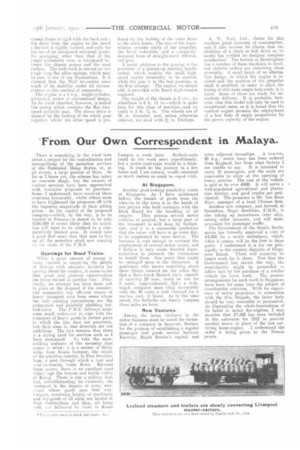- From Our Own Correspondent in Malaya.
Page 7

If you've noticed an error in this article please click here to report it so we can fix it.
There is something in the wind here about a project for the centralization and monopolizing of the motorbus services of the Federated Malay States, or, at all events, a large portion of them. So far as I know yet, the scheme has taken no concrete shape, but the owners of various services have been approached with tentative proposals to purchase. Some, I understand, have received these overtures favourably, whilst others seem to have frightened the proposers off with the imposing magnitude of their selling prices. As the capital of the proposed company—which, by the way, is to be located at Penang—is stated to be only $350,000 it. seems likely that its activities will have to be confined to a COMparatively limited area. It would take a good deal more than that sum to buy up all the motorbus stock now running on the roads of the P.M.S.
Openings for Road Trains.
While a great amount of energy is being exerted in supplying the people of Malaya with adetetate facilities for moving about the country, it seems to me that great and elerious opportunities are being missed in another way. Practically, no attempt has been made yet to place at the disposal of the commercial community any efficient Me0113 of heavy transport over busy areas where the only existing conveyances are the antiquated and painfully plodding bul
lock-carts. The F.M.S. railways make some small endeavour to cope with the transport of heavy goods in certain parts to which the hue does not penetrate, but their aims in that direction are not ambitious. The fact remains that there is a crying need for services such as I
have mentioned. To take the moststriking instance of the necessity that comes to mind: it is a matter of thirty miles from Kuala Lumpur, the centre cf the planting country, to Port Swettenham, a port through which a vast and
verincreasing trade flows. Bet ween these pointa, there is an excellent road which taps the famous and fertile valley of Kiang. There is also a railway line, but, notwithstanding its existence, the transport is the despair of every merehant whose goods pass that way. t'argees, consisting largely of machinery aad dry-goods of all sorts, are landed at Port Swettenham and then, all being well, aae delivered by train in Kuala Lumpur a week later. Bullock-carts
could do the work more expeditiously, but a motor road-train would be a blessing. It could do the journey in a few hours and, I am certain, would command as much custom as could be coped with.
At Singapore.
Another good-looking possibility exists at Singapore. As I have mentioned before, the transit of goods from the wharves to the town is in the hands of two parties who hold contracts with the Dock Board for the handling of all cargoes. They possess several motor vehicles at present, but a large part of the transport is still done by bullockcart, and it is a reasonable prediction that the latter will have to go some day, to be supplanted by more motors. The business is vast enough to warrant the employment of several motor trains, and I believe it only needs forceful representations to persuade the contractors to install them. One point that mightbe enlarged upon is the cheapness. A gentleman who knows something about these things assured me the other day that a three-truck Renard train, capable of carrying 20 tona, could be run for 8 cents. (approximately 2ad.) a mile, which compares more than favourably with the 40 cents a mile charged for a one ton cart, if hired. As to the time saved, the bullocks can barely compass three miles an hour.
New Ventures.
Among the latest ventures in the motor business must be noted the formation of a company in Sarawak, -Borneo, for the purpose ot establishing a regular passenger and goods service between Kerhing, Rajah Brooke's capital, and
some adjacent townships. A two-ton, 20 hap., motor lorry has been ordered from England, but from what factory 1 am unable to say. It is intended to carry 16 passengers, and the seats are removable to allow of the carrying of heavy articles. The cost of the vehicle is said to be over .£600. It will serve a well-populated agricultural and plantation district, and good results arc anticipated. The promoter is Mr. Tan Boon Sieve, manager of a local Chinese firm.
Another new company, just formed, at Seremban, Negri Sembilan, F.M.S., is also taking up motorbuses inter edict, among other interests, and will make P'°'°' for passenger traffic.
The Government of the Straits Settlements has formally approved a vote of $4,000 for a motor ambulance, which, when it comes, will be the first in these parts. I understand it is for use principally in the country districts of Singapore Island. There will certainly he ample work for it there. Now that the Government has shown the way, the municipality might be persuaded to follow suit, by the purchase of a similar vehicle for town work. The present arrangements for such work in Singapore have been for some time the subject of considerable criticism. With its experience of motor propulsion in connection with the Fire Brigade, the latter body should be very amenable to persuasion. As illustrating the whole-heartedness of its belief in motor fire-engines, I may mention that 87,500 has been included in the estimates for 1912 to provide another Motor in place of the last surviving horse-engine. I understand the order is being given to the Dennis people.






















